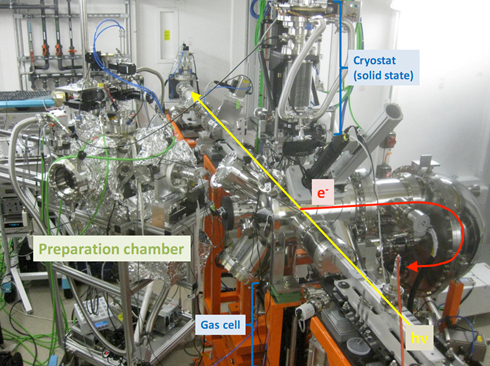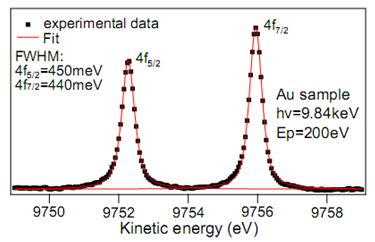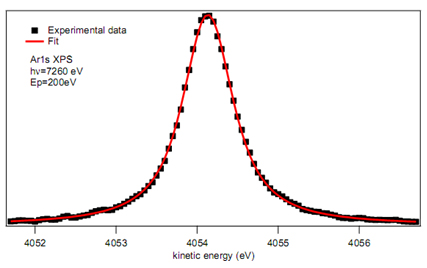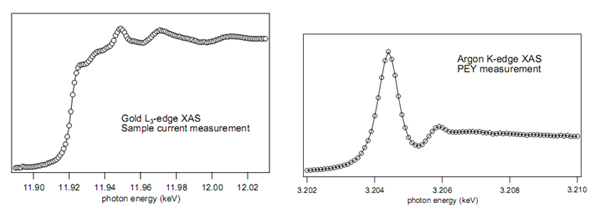With the HAXPES1 station installed on the GALAXIES beamline, high kinetic energy photoemission experiments can now be performed on solid or gas samples, and in the near future also on liquids. The following is a short summary of the advantages of this technique, so far never used on dilute matter.
The electron spectrometer on the GALAXIES beamline can analyze kinetic energies ranging from a few tens of eV to more than 10 keV, making this device a unique experimental station at SOLEIL. Analysis of the photoemission spectra provides important information on the electronic structure of the irradiated samples, as well as some photo-induced dynamic processes such as charge transfer or nuclear movements, notably in the dilute phase.

The HAXPES experimental setup on the GALAXIES beamline
Advantages of high energy compared to soft X-rays and VUV
The use of high energy, both for sample excitation and its analysis, has several advantages. On the one hand, regardless of the nature of the irradiated sample (solid, gas, liquid), X-rays can be used to ionize a particular inner shell and thus to focus on a given chemical element. This is the principle of ESCA (Electron Spectroscopy for Chemical Analysis), developed by K. Siegbahn who was awarded the Nobel Prize for it in 1981. Analysis of the emitted electron gives information on the ionized component and its chemical environment. According to the chemical environment of the "targeted" atom, small displacements in photoemission peaks are observed. Deeper, highly localized electron shells can be reached by increasing the photon energy, the ionization of these electron shells leading to very unstable states over time scales shorter than a fs (10-15 s).
On the other hand, when studying condensed matter, producing high kinetic energy electrons allows their mean free path to be increased. Using HAXPES, it is possible to probe materials down to depths about 10 times greater than with standard photoemissions mostly performed in the soft x-ray regime, which opens the way for the study of buried interfaces, as well as that of the mobility of ions in liquid solutions. In addition, the ejection of an electron by giving it a high kinetic energy has the effect of inducing a nuclear recoil. Although quite weak due to the electron/nuclear mass ratio, this nuclear recoil, visible on photoemission and Auger spectra [1], is still a poorly understood phenomenon which goes beyond the scope of the 'usual' treatment of the photoionization process, namely decoupling the functions describing the motion of nuclei from that of electrons.
Moreover, GALAXIES’ energy range allows for studies of ultrafast temporal dynamics. Indeed, when a core electron is promoted to an empty electron orbital, the resulting excited state has a very short lifetime of few fs or less. This time scale is very useful to determine ultrafast processes such as charge transfer [2] or potential competition between nuclear motion and electronic decay. These very short lifetimes also result in significant interference effects between different relaxation pathways, which are demonstrated by measuring the energy of the emitted electrons [3].
Constraints/limitations
The resolving power of high kinetic energy electron analyzers is lower than at a lower energy. Also, the decrease of the ionization cross section at high energy must be compensated for as much as possible. This is the case on the GALAXIES beamline with the large acceptance angle of the analyzer and the high photon flux.
Conclusion
The HAXPES experimental station on GALAXIES is therefore regarded as an extension on the high photon energy side of the tools already used on the photoemission beamlines. This technique, now quite popular in the field of solid state physics, has really taken off and is used by several groups around the world. For the study of dilute matter and very soon liquids, this technique is for the time being available only at SOLEIL.
First results obtained on GALAXIES

Figure 1: 4f hard X-ray photoemission spectrum of gold. The spectrum is recorded at hn = 9.84keV using a Si (444) monochromator, leading to a resolution of Dhn»60meV.
Example of high photon energy /high resolution gas measurement

Figure 2: photoemission spectrum of argon 1s shell, recorded at 7260 eV photon energy with a resolution of Dhn»70 meV.
Example of tunability

Figure 3: gold L3-edge XAS (sample current measurement) and argon K-edge XAS (partial electron yield measurement) spectra.
1 – HAXPES: Hard X ray photoemission spectroscopy
[1] nuclear recoil induces photon energy dependence of the Auger decay: SOLEIL proposal 20120642
[2] ultrafast charge transfer: SOLEIL proposal 20120122
[3] lifetime interference effects: SOLEIL proposal 20120010
